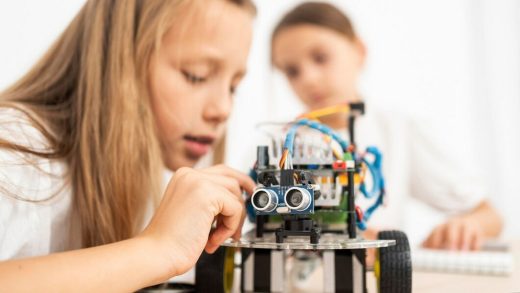STEM methodology: a holistic approach to the education of the future, classroom training tips
STEM methodology: a holistic approach to the education of the future
25 June 2024
In an ever-changing world, education cannot be left behind. The STEM (Science, Technology, Engineering and Mathematics) methodology emerged as a response to the need to train students with practical skills and knowledge applicable in the real world.
This methodology has become a fundamental pillar in education, preparing young people for the challenges of the 21st century and encouraging innovation and critical thinking from an early age. In this context, academies such as STEM Academy play a crucial role, offering educational programmes that integrate these disciplines in an effective and attractive way.
Read on because I’ll tell you everything you need to know about this methodology!
What is the STEM methodology?
The STEM methodology is an interdisciplinary educational approach that integrates the areas of science, technology, engineering and mathematics. Unlike traditional methods that teach these disciplines in isolation, STEM combines them to offer a more coherent and realistic learning experience.
The main idea is for students to understand how these fields interact and complement each other in the real world, enabling them to develop skills that are crucial for solving complex problems and carrying out innovative projects.
In this way, the aim of STEM education is not only to impart theoretical knowledge, but also to foster practical skills and critical thinking. Students learn to ask questions, investigate, experiment and find solutions – skills that are essential in both academia and the world of work.
1. Science
Science is at the core of the STEM methodology and involves the observation, identification, description, experimental investigation and theoretical explanation of natural phenomena. Students enter the world of biology, chemistry, physics and environmental science, learning to formulate hypotheses, conduct experiments and analyse data.
This process not only helps them understand how the natural world works, but also teaches them to think logically and systematically.
Science projects in a STEM environment are often collaborative and hands-on, allowing students to work in teams to solve real problems. This experience not only reinforces their understanding of scientific concepts, but also develops their communication and teamwork skills.
2. Technology
Technology is an integral part of our lives and STEM methodology could not ignore it. In this context, technology does not refer only to electronic devices, but to the practical application of scientific knowledge to develop innovative tools, processes and solutions.
Students in STEM programmes learn about programming, robotics, graphic design and many other technological areas, developing skills that are essential in the digital age.
Technology learning in STEM is not passive; students create, design and build. This hands-on approach not only makes learning more exciting and relevant, but also fosters creativity and innovative thinking, skills that are highly valued in today’s professional world.
3. Engineering
Engineering in STEM methodology focuses on applying scientific and mathematical principles to design and build practical solutions to real problems. Students learn about different branches of engineering, such as civil, mechanical, electrical and environmental engineering, and face challenges that require the application of their theoretical knowledge in tangible projects.
The focus on engineering within STEM helps students develop problem-solving skills, critical thinking and creativity. It also fosters a mindset of ingenuity and persistence, teaching them that mistakes are opportunities to learn and improve.
4. Mathematics
Mathematics is central to the STEM methodology, providing the tools necessary to understand and describe the world. From basic arithmetic to advanced calculus, mathematics is essential to all areas of STEM. Students learn to use mathematical thinking to analyse data, solve problems and make informed decisions.
In a STEM environment, mathematics is not seen as a set of abstract rules, but as a universal language that can describe and solve real-world problems. This perspective helps students to appreciate the relevance of mathematics in their daily lives and future careers.
STEM Academies: the education of the future
STEM academies play a crucial role in promoting and teaching STEM methodology. These institutions are dedicated to offering educational programmes that integrate science, technology, engineering and mathematics in an interdisciplinary and practical way. One of the most prominent in this field is STEM Academy, an institution recognised for its educational excellence and innovative approach.
STEM Academy offers a wide variety of programmes and master’s degrees designed to prepare students for careers in STEM-related fields. Its masters, such as the Master in Robotics Engineering, Master in Data Science and Master in Information Technology, are highly valued in the industry and offer a comprehensive education that combines theory and practice.
In conclusion, the STEM methodology represents a significant shift in education, preparing students to meet the challenges of the future with practical skills, critical thinking and creativity. By integrating science, technology, engineering and mathematics, STEM offers a more relevant and applied education that fosters innovation and lifelong learning.
Indeed, STEM academies are essential in this process, offering programmes that prepare students to excel in an increasingly technological and interconnected world.
Comments on this guide to STEM methodology: a holistic approach to the education of the future article are welcome.
School Design and Architecture Education
School Building Design and Architectural Education Posts
Want to continue architectural education
Educational journey of architecture students
High school students career in architecture
Buildings
Contemporary Property Articles
Comments / photos for the STEM methodology: a holistic approach to the education of the future page welcome







